Human Metapneumovirus (hMPV): What Cancer Patients Need to Know
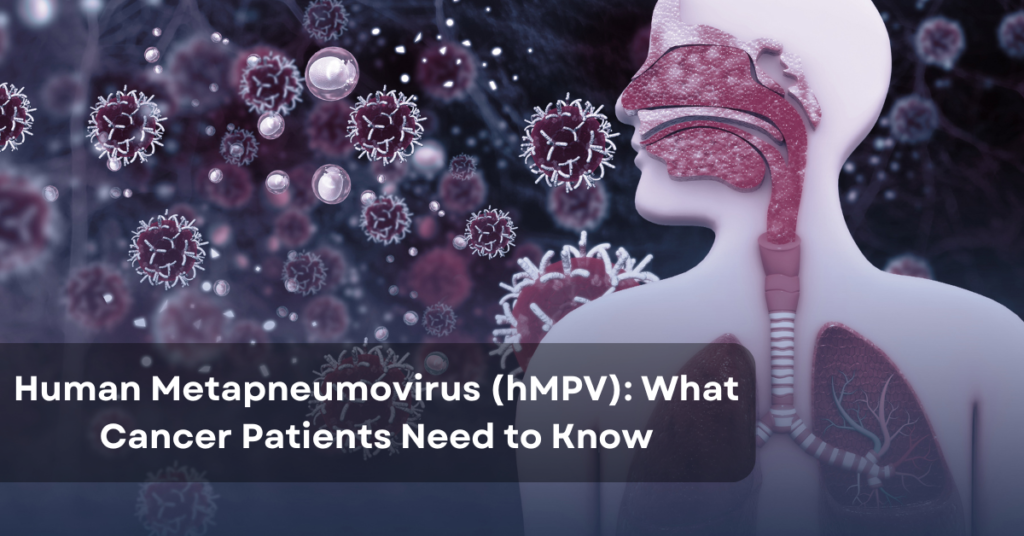
As an oncologist specializing in cancer care, I, Dr. Saadvik Raghuram, believe it’s crucial to shed light on infections like Human Metapneumovirus (hMPV)—a potentially severe threat for individuals with compromised immune systems, such as cancer patients undergoing treatment. What is Human Metapneumovirus (hMPV)? Discovered in 2001, Human Metapneumovirus (hMPV) is a respiratory virus from the Paramyxoviridae family, closely related to the Respiratory Syncytial Virus (RSV). While healthy individuals often experience mild symptoms, hMPV can cause severe respiratory illness in: Common Symptoms of hMPV The symptoms of hMPV range from mild to severe respiratory distress. Common signs include: How Does hMPV Spread? hMPV is highly contagious and spreads through: Why is hMPV a Serious Concern for Cancer Patients? Cancer treatments like chemotherapy, radiation, or stem cell transplants weaken the immune system, leaving patients more vulnerable to infections. For these individuals, even a seemingly mild cold can escalate into life-threatening complications. Preventing hMPV Infections Currently, there is no specific vaccine or antiviral treatment for hMPV. However, preventive measures can significantly reduce the risk: Treatment Options for hMPV Treatment for hMPV focuses on managing symptoms, as no targeted antiviral treatments currently exist: Conclusion by Dr. Saadvik Raghuram Human Metapneumovirus (hMPV) might not be as well-known as other respiratory illnesses, but its potential impact on vulnerable groups—especially cancer patients—is significant. Staying informed, taking preventive measures, and seeking timely medical care are essential to safeguarding your health.As one of the best oncologists in Hyderabad, I am committed to delivering comprehensive care that addresses not only cancer but also associated health risks. If you or your loved ones have concerns about hMPV or any other health issues, I’m here to provide expert guidance. Stay vigilant, prioritize your health, and follow my blog for more valuable insights.
Understanding Cancer Fatigue: Causes, Symptoms, and Management Tips
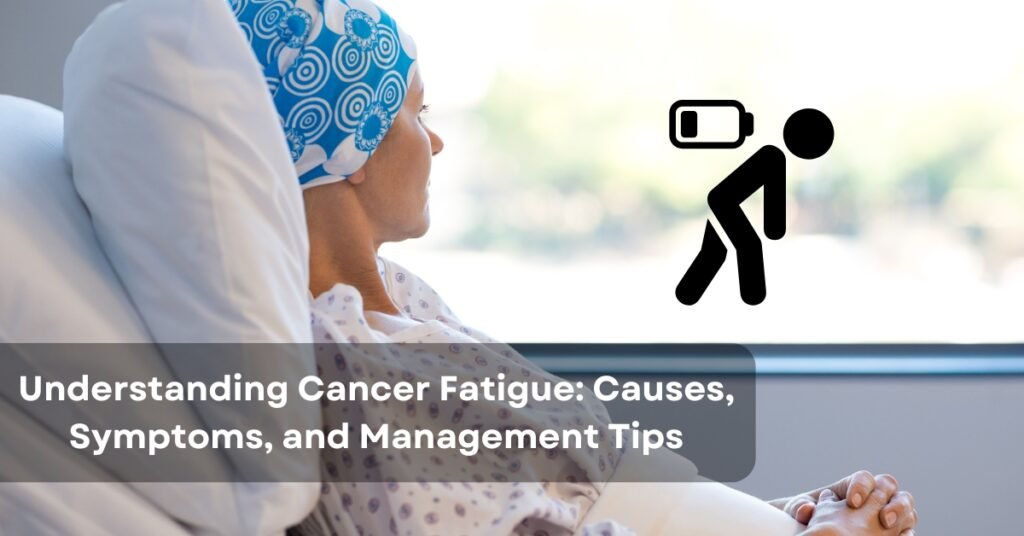
Cancer fatigue is one of the most common and challenging symptoms experienced by cancer patients. Unlike ordinary tiredness, this form of fatigue is pervasive, often unrelenting, and not entirely relieved by rest. Understanding and managing this condition can significantly improve the quality of life for patients undergoing treatment or in recovery. What is Cancer Fatigue? Cancer fatigue is defined as a persistent sense of tiredness or exhaustion related to cancer or its treatment. It is different from the usual fatigue people experience after physical or mental exertion. Cancer fatigue can occur suddenly, without warning, and is not always proportional to recent activities. It can last for weeks, months, or even years after treatment ends. Causes of Cancer Fatigue The causes of cancer fatigue are multifaceted and may vary from patient to patient. Some of the key contributors include: Symptoms of Cancer Fatigue Patients experiencing cancer fatigue may report: How to Manage Cancer Fatigue While cancer fatigue can be overwhelming, there are ways to manage and alleviate its impact. Here are practical tips: 1. Energy Conservation 2. Physical Activity 3. Nutrition 4. Sleep Hygiene 5. Mental Health Support 6. Medication and Medical Interventions When to Seek Help While fatigue is common during cancer treatment, it’s essential to recognize when it may indicate a more serious issue. Contact your doctor if: Dr. Saadvik Raghuram: Your Trusted Oncologist in Hyderabad Dr. Saadvik Raghuram, a distinguished medical oncologist based in Hyderabad, is dedicated to helping patients navigate the challenges of cancer and its treatment, including addressing symptoms like cancer fatigue. By understanding the complexities of this condition, Dr. Raghuram empowers his patients with strategies to regain energy and enhance their quality of life. Conclusion Cancer fatigue is a complex and multifaceted challenge that requires a comprehensive approach to manage. By understanding its causes, recognizing its symptoms, and adopting practical strategies, patients can take steps to improve their quality of life. Always consult with your healthcare provider to tailor a management plan to your specific needs. FAQs About Cancer Fatigue Q1: Is cancer fatigue the same as regular tiredness? A1: No, cancer fatigue is more severe and persistent than regular tiredness. It often doesn’t improve with rest and can significantly impact daily life. Q2: Can cancer fatigue last after treatment ends? A2: Yes, some patients experience fatigue for months or even years after completing treatment. However, its intensity usually decreases over time. Q3: Are there medications to treat cancer fatigue? A3: There isn’t a specific medication for cancer fatigue, but treatments for underlying causes, such as anemia or depression, can help alleviate symptoms. Q4: How does exercise help with cancer fatigue? A4: Regular, gentle exercise improves circulation, reduces inflammation, and boosts overall energy levels, making it an effective strategy for managing fatigue. Q5: Should I push through cancer fatigue? A5: It’s essential to listen to your body. While some activity is beneficial, overexertion can worsen fatigue. Balance rest and activity based on your energy levels.
Obesity and Cancer: An Oncologist’s Perspective
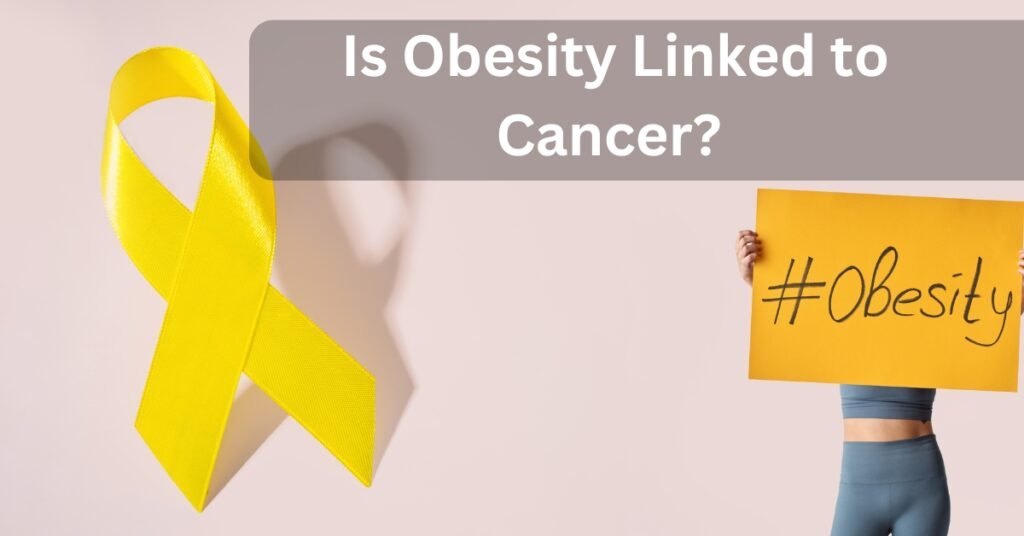
As an oncologist, one of the most pressing public health concerns I encounter is the growing prevalence of obesity and cancer and their significant interconnection. While many people understand that obesity increases the risk of heart disease and diabetes, fewer realize its strong link to cancer. Research highlights that excess body weight is not just a cosmetic issue but a major risk factor for several types of cancer. In this blog, I’ll explore the relationship between obesity and cancer, the mechanisms behind it, and practical steps to reduce this risk. The Growing Obesity Epidemic Obesity has become a global epidemic, impacting millions worldwide. According to the World Health Organization (WHO), over 650 million adults are obese. In the U.S. alone, nearly 40% of adults are affected. Obesity, defined as a body mass index (BMI) of 30 or higher, contributes to a range of health problems, including cancer. Beyond appearances, obesity influences hormone levels, inflammation, and the immune system, all of which are critical in cancer development. Understanding the connection between obesity and cancer can empower us to take preventive measures. The Link Between Obesity and Cancer Research shows a direct relationship between obesity and cancer. According to the American Cancer Society, being overweight or obese increases the risk of at least 13 cancers, including: How Does Obesity Increase Cancer Risk? Several biological mechanisms drive the connection between obesity and cancer: Specific Cancers Linked to Obesity Certain cancers are more strongly associated with obesity: Can Losing Weight Reduce Cancer Risk? Weight loss can significantly lower the risk of obesity-related cancers. Studies reveal that even modest weight reduction reduces insulin, estrogen, and inflammation levels, which are linked to cancer development. Preventive Measures: Lifestyle Changes Taking proactive steps can reduce the risk of both obesity and cancer: Conclusion: Addressing Obesity to Reduce Cancer Risk The connection between obesity and cancer underscores the importance of maintaining a healthy weight. Obesity-driven changes in hormones, inflammation, and metabolism contribute significantly to cancer risk. However, these risks are largely preventable through lifestyle changes. As an oncologist, I stress that reducing obesity is not just about aesthetics; it’s a critical step in cancer prevention. Small, consistent efforts like healthy eating and regular exercise can make a significant impact on your health and future. Contact us for more information. FAQs about Obesity and Cancer Q1: How strong is the link between obesity and cancer?Research indicates that obesity is a major risk factor for at least 13 types of cancer, including breast, colorectal, and endometrial cancers. Q2: Can losing weight reduce the risk of cancer?Yes. Studies show that even modest weight loss can lower levels of cancer-linked hormones like estrogen and insulin, reducing the risk. Q3: Are all obese individuals at risk of cancer?While obesity increases risk, other factors like genetics, lifestyle, and environmental exposures also play a role in cancer development. Q4: What lifestyle changes can prevent obesity-related cancer?Adopting a healthy diet, engaging in regular exercise, avoiding smoking, and limiting alcohol consumption can significantly reduce the risk. Q5: Is BMI the best measure for cancer risk assessment?BMI is a useful tool but not a perfect measure. Other factors, like fat distribution and overall health, also influence cancer risk.
Can Diet Alone Cure Cancer? An Oncologist’s Perspective

As an oncologist, one of the most common questions I encounter from patients and their families is whether dietary changes alone can cure cancer. With the rise of alternative medicine, holistic health trends, and an overwhelming amount of information available online, many people wonder if something as simple and accessible as food can be a powerful tool in fighting cancer. While diet plays an important role in overall health and can support cancer treatment, it is critical to understand that diet alone cannot cure cancer. The Role of Diet in Cancer Treatment There is no denying the significance of nutrition in cancer care. A balanced, nutrient-rich diet is essential for maintaining strength, energy, and overall well-being during cancer treatment. Chemotherapy, radiation, and surgery can be physically demanding on the body, and proper nutrition can help manage side effects like fatigue, weight loss, and reduced immune function. For example, a diet high in antioxidants, vitamins, and minerals can help boost the immune system and support the body in its ability to fight off infection. Additionally, some research suggests that certain dietary patterns—such as a Mediterranean diet or plant-based eating—might be associated with lower risks of certain types of cancer or better outcomes in cancer patients. The idea is that nutrient-dense foods such as fruits, vegetables, whole grains, legumes, and healthy fats may contribute to the prevention of cancer through their anti-inflammatory and antioxidant properties. However, it’s crucial to differentiate between using diet as a complementary approach to medical treatment and viewing it as a stand-alone cure. While food has a significant impact on health, it cannot replace the scientific, evidence-based therapies that are proven to treat cancer. Why Diet Alone Can’t Cure Cancer Cancer is a complex and multifactorial disease. It involves mutations in DNA that cause cells to grow uncontrollably, evading the normal regulatory processes that maintain cellular balance. These mutations are not something that can be directly “fixed” by food. While some dietary components might influence genetic expression or reduce inflammation, there is no scientific evidence that a specific diet alone can reverse cancerous growth. Cancer treatment typically involves a combination of surgery, radiation, chemotherapy, immunotherapy, and targeted therapies, all of which are developed based on extensive research and clinical trials. These treatments are designed to target and kill cancer cells, shrink tumors, and manage the spread of cancer. Diet, on the other hand, supports the body during this process, but it does not directly target or kill cancer cells in the same way medical treatments do. The Dangers of Relying Solely on Diet One of the dangers of believing diet can cure cancer is that it may lead some patients to delay or forgo proven medical treatments in favor of unproven dietary regimens or supplements. While some alternative therapies can be supportive, they should never replace conventional cancer treatments. In fact, there have been cases where patients, after opting for dietary or herbal remedies instead of standard care, have experienced progression of their cancer or worsened outcomes. Additionally, certain restrictive diets can result in malnutrition, which can weaken the body’s ability to tolerate cancer treatments. A weakened immune system, insufficient calorie intake, or deficiency in essential nutrients can make it harder for the body to fight cancer and recover from treatment. Integrating Diet with Medical Treatment While diet alone can’t cure cancer, a healthy diet can certainly improve quality of life during treatment and may help reduce the risk of recurrence once treatment is complete. As part of a comprehensive cancer care plan, a nutritionist or dietitian can guide patients on the best foods to support their treatment. Here are some general recommendations:1. Maintain Nutritional Balance: Focus on a diet rich in whole foods—fruits, vegetables, lean proteins, whole grains, and healthy fats.2. Stay Hydrated: Adequate water intake is essential to keep the body functioning properly, especially during treatments like chemotherapy or radiation, which can dehydrate the body.3. Manage Side Effects: If treatment causes nausea, loss of appetite, or difficulty swallowing, a dietitian can help customize meals to make eating easier and more enjoyable.4. Limit Processed Foods: High intake of processed foods, red meats, and sugary snacks has been associated with increased risks of certain cancers, so focusing on whole, minimally processed foods is a smart strategy.5. Consider Supplements Cautiously: Some cancer patients turn to vitamins or herbal supplements in hopes of improving their prognosis. While certain supplements, like vitamin D or omega-3 fatty acids, may have a beneficial role, it’s important to consult with a doctor before starting any new regimen. Some supplements can interfere with cancer treatments or cause harmful side effects. Cancer is a serious, multifaceted disease that requires a well-rounded, scientifically-backed treatment approach. While diet plays an essential role in supporting overall health, energy, and recovery during cancer treatment, it should never be considered a replacement for conventional cancer therapies. Diet is a complementary tool, not a standalone cure. For cancer patients, the best approach is to work with a team of healthcare providers—oncologists, dietitians, and other specialists—to create a comprehensive care plan that addresses all aspects of treatment, from medical interventions to nutrition and emotional support. In the battle against cancer, there is no magic bullet. But with the right combination of treatments, including a healthy, balanced diet, we can offer the best chance for long-term survival and a good quality of life.
Does Vaping Reduce Lung Cancer Risk? Insights from an Oncologist
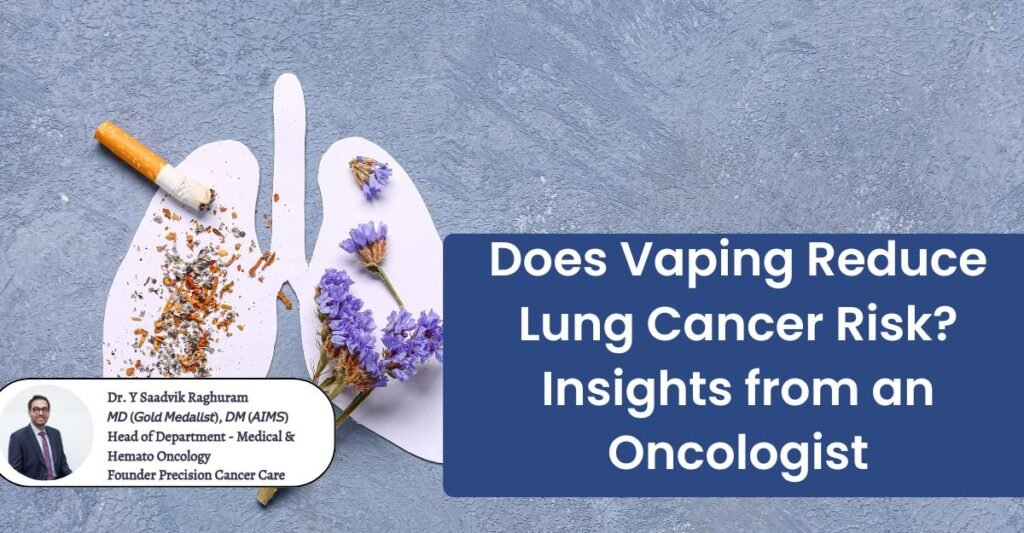
Lung cancer remains one of the leading causes of cancer-related deaths worldwide, with smoking being the primary culprit. As the dangers of traditional cigarettes have become widely known, many people have turned to vaping as a potential “safer” alternative. But does vaping actually reduce the risk of lung cancer compared to smoking? Let’s explore the facts from an oncologist’s perspective. Understanding Vaping: What Is It? Vaping involves inhaling aerosol (commonly referred to as vapor) produced by an electronic cigarette or similar device. The device heats a liquid—usually containing nicotine, flavorings, and other chemicals—into an aerosol that the user inhales. Although vaping eliminates some of the harmful chemicals produced by burning tobacco, like tar and carbon monoxide, it is far from risk-free. Vaping vs. Smoking: A Comparative Risk for Lung Cancer Traditional cigarettes contain more than 70 known carcinogens (cancer-causing substances), making them highly dangerous to lung health. Cigarette smoke causes long-term damage to the lungs, leading to the development of lung cancer over time. Vaping products, on the other hand, often contain fewer toxic chemicals than cigarettes, which has led to claims that they are safer. However, while vaping may reduce exposure to some of the most harmful substances in cigarettes, it does not eliminate cancer risk. Here’s why: Can Vaping Help Smokers Reduce Lung Cancer Risk? There is some evidence to suggest that vaping can help heavy smokers reduce their cigarette consumption or even quit smoking altogether. For smokers unable to quit through other means, switching to vaping may be a less harmful alternative to traditional cigarettes. But this should not be seen as a long-term solution. It’s important to note that while vaping may be less harmful than smoking, it is not harmless. The best way to reduce the risk of lung cancer is to eliminate the use of all tobacco and nicotine products. What About Non-Smokers Who Vape? Vaping has become popular among younger populations, including those who have never smoked cigarettes. This is particularly concerning because non-smokers who start vaping are exposing themselves to harmful chemicals unnecessarily, increasing their risk of lung damage and potentially lung cancer over time. For non-smokers, vaping provides no health benefit and should be avoided altogether. Final Thoughts: Reducing Lung Cancer Risk Vaping may be less harmful than smoking cigarettes, but it is not a safe alternative. The best way to reduce the risk of lung cancer is by quitting smoking or vaping entirely and avoiding exposure to harmful chemicals in any form. If you’re a smoker looking to quit, speak with your healthcare provider about evidence-based cessation methods, such as nicotine replacement therapy, prescription medications, and counseling. In conclusion, while vaping might reduce some risks compared to traditional smoking, it does not eliminate the potential for lung cancer. Both smoking and vaping pose health risks, and the only truly safe option is to quit both entirely. Contact us for more
What is Triple-Negative Breast Cancer?
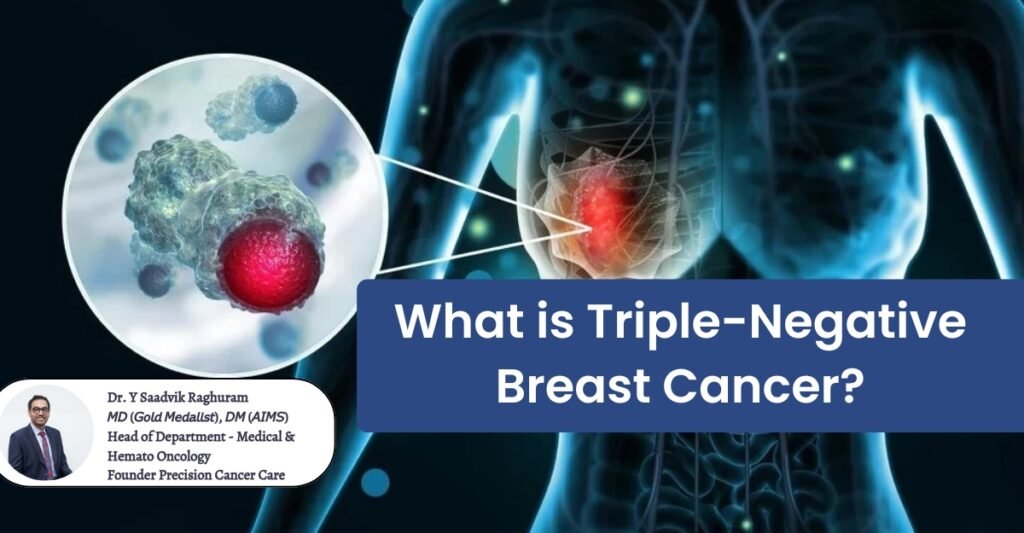
Triple-negative breast cancer (TNBC) is a subtype of breast cancer that is characterized by the absence of three common receptors: estrogen, progesterone, and HER2. Understanding these receptors is essential because they often guide treatment options for breast cancer patients. In the case of TNBC, the lack of these receptors makes it more challenging to treat compared to other types of breast cancer. The Basics of Breast Cancer Receptors Breast cancer cells are typically tested for the presence of three receptors that influence tumor growth: In patients with triple-negative breast cancer, the tumor tests negative for all three of these receptors, meaning it does not respond to hormonal therapies or drugs that target HER2, such as tamoxifen or trastuzumab. Why is Triple-Negative Breast Cancer Different? TNBC is considered more aggressive than other forms of breast cancer for several reasons: Who is at Risk for TNBC? TNBC is more likely to affect younger women, particularly those under 40, and is more common in women of African or Hispanic descent. Additionally, women with mutations in the BRCA1 gene are at a higher risk for developing TNBC. Treatment Options for Triple-Negative Breast Cancer The standard treatment for TNBC often involves a combination of: Conclusion Triple-negative breast cancer is a challenging diagnosis due to its aggressive nature and limited treatment options. However, ongoing research and new therapies offer hope for more effective treatment. If you or a loved one has been diagnosed with TNBC, it’s important to work closely with your oncologist to determine the best treatment plan. If you have any questions or need support regarding TNBC or any type of breast cancer, feel free to reach out to us for expert guidance and compassionate care.
Targeted Therapy in Cancer: A Personalized Approach to Treatment
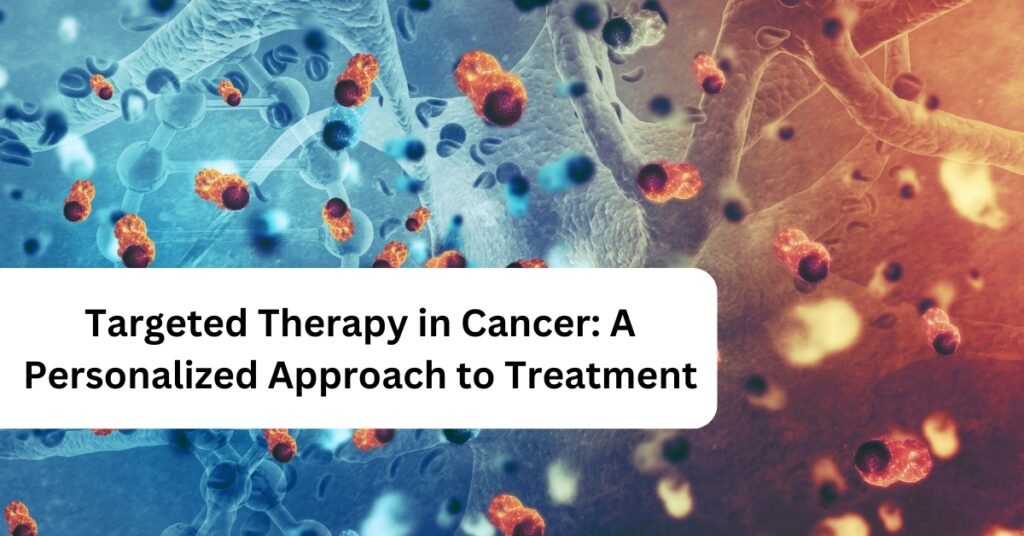
Unlike traditional treatments such as chemotherapy and radiation, which attack both healthy and cancerous cells, targeted therapy takes a more precise approach. This innovative treatment zeroes in on specific molecules or genetic markers involved in cancer growth, offering a more tailored and often less toxic alternative for patients. What is Targeted Therapy? Targeted therapy is a type of cancer treatment that focuses on specific genes, proteins, or other cellular mechanisms involved in cancer cells’ growth and survival. By blocking these targets, the therapy can slow down or stop cancer growth while sparing healthy cells. This differs from conventional treatments, which can’t distinguish between cancerous and non-cancerous tissues, often leading to widespread side effects. There are two main types of targeted therapy: How Does Targeted Therapy Work? Cancer cells often have mutations or abnormal proteins that allow them to grow uncontrollably. Targeted therapy works by identifying these abnormalities and blocking the processes that allow the cancer to thrive. For example, some breast cancers are driven by an excess of the HER2 protein. Targeted drugs like trastuzumab (Herceptin) specifically inhibit HER2, slowing or halting the growth of these cancer cells. Another well-known example is in lung cancer, where certain mutations in the EGFR gene drive cancer growth. Targeted drugs like erlotinib (Tarceva) or osimertinib (Tagrisso) can block these mutated proteins, leading to more effective treatment with fewer side effects compared to traditional chemotherapy. Advantages of Targeted Therapy Limitations and Challenges While targeted therapy has revolutionized cancer treatment, it’s important to understand its limitations. Not all cancers have identifiable targets, and in some cases, cancer cells may develop resistance to these therapies over time. This resistance can occur when cancer cells adapt or find alternative pathways to grow. Additionally, targeted therapy may work best when combined with other treatments, such as chemotherapy, radiation, or immunotherapy. Research is ongoing to find ways to overcome resistance and expand the use of targeted therapies for more cancer types. Who Can Benefit from Targeted Therapy? Targeted therapy is not suitable for every cancer or every patient. It’s most effective for cancers that have specific genetic mutations or molecular markers, such as: Before starting treatment, patients often undergo molecular testing or a biopsy to determine whether their tumor has specific genetic alterations that can be targeted. This personalized approach ensures that the treatment is as effective as possible. The Future of Targeted Therapy The field of targeted therapy is continually evolving, with new treatments being developed and approved each year. As research into cancer genetics and molecular biology advances, we expect to see even more targeted options that can benefit a wider range of cancer types. These advancements not only improve survival rates but also offer patients a better quality of life during treatment. At my practice, I believe in offering cutting-edge cancer treatments, including targeted therapy, as part of a comprehensive and personalized care plan. By staying at the forefront of cancer research, I’m able to provide patients with the latest and most effective options available. If you’re interested in learning more about targeted therapy and whether it might be right for your cancer treatment, I encourage you to schedule a consultation. Together, we can explore the best course of action to tackle your cancer with precision and care.
Immunotherapy: A Breakthrough in Cancer Treatment
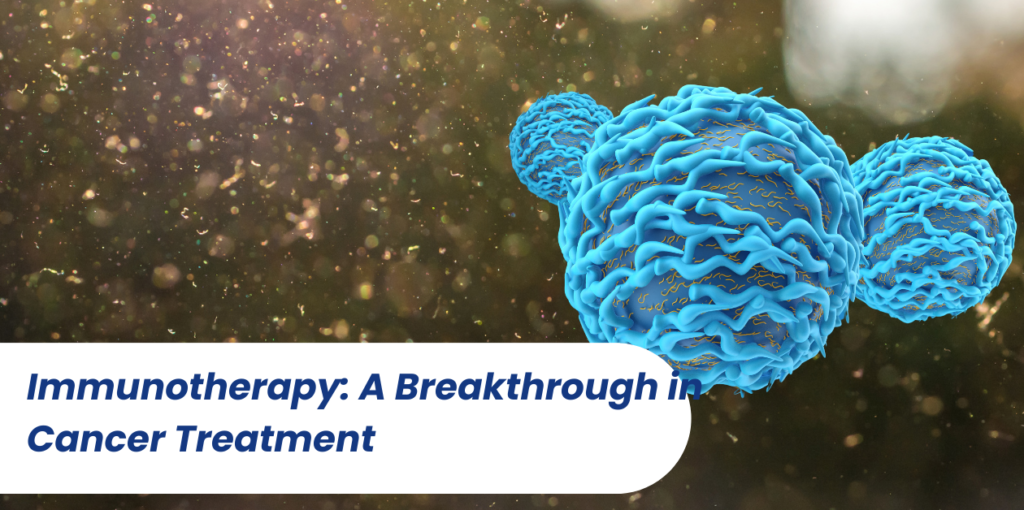
As an oncologist, I’ve seen remarkable progress in cancer treatments over the years. One of the most promising advancements is immunotherapy—a treatment designed to harness the power of your immune system to fight cancer. For patients battling cancers like melanoma, lung cancer, and more, immunotherapy has emerged as a game-changer, offering hope in cases where other treatments may have fallen short. What is Immunotherapy? Immunotherapy is a type of cancer treatment that uses the body’s immune system to identify and destroy cancer cells. Unlike chemotherapy or radiation, which target cancer cells directly, immunotherapy strengthens or manipulates the immune system to do the work. This approach can offer a more targeted, and sometimes less toxic, alternative to traditional cancer therapies. There are several types of immunotherapy, including: How Does Immunotherapy Work? The immune system is adept at fighting infections and diseases, but cancer cells can sometimes hide from immune detection. Immunotherapy works by removing the “brakes” that cancer cells use to evade immune responses. This allows the immune system to recognize better and attack these rogue cells. Checkpoint inhibitors, for example, block proteins like PD-1 or CTLA-4 on immune cells, which normally act as checkpoints to prevent immune overactivity. When these proteins are blocked, the immune system becomes more aggressive toward cancer cells. This has been particularly effective in treating cancers such as non-small cell lung cancer, melanoma, and certain types of kidney and bladder cancers. Benefits of Immunotherapy One of the most significant benefits of immunotherapy is its potential for long-lasting effects. In many cases, patients who respond to immunotherapy treatments continue to experience remission even after the therapy has ended. Some patients with advanced cancer have even seen their tumors shrink dramatically or disappear. Immunotherapy also tends to have fewer side effects than chemotherapy or radiation, which can damage healthy cells. Instead of attacking both healthy and cancerous cells, immunotherapy primarily enhances the immune system’s ability to target cancer. Challenges and Considerations While immunotherapy offers immense promise, it’s not without challenges. Not all patients respond to this treatment, and predicting who will benefit remains a key area of research. Additionally, some patients experience immune-related side effects, where the immune system may attack healthy tissues. These side effects can range from mild inflammation to more severe complications in organs like the liver, lungs, or skin. It’s also important to note that immunotherapy may not be a stand-alone solution for every cancer type. For some, it works best when combined with other treatments like chemotherapy, radiation, or surgery. The success of immunotherapy varies depending on the type and stage of cancer, as well as individual patient factors. Immunotherapy and the Future of Cancer Treatment Immunotherapy represents a new frontier in cancer treatment, one that is still evolving. Ongoing research and clinical trials are exploring how to make this therapy even more effective, and we’re learning more every day about which cancers are most responsive. As an oncologist, I believe in providing patients with the most advanced, personalized care possible. Immunotherapy allows us to offer new treatment avenues, particularly for those who may have run out of traditional options. It’s a testament to how far we’ve come in understanding and treating cancer, and I’m optimistic about the future. If you or a loved one are considering immunotherapy, discussing the potential benefits, risks, and treatment options with your oncology team is essential. Together, we can explore whether this innovative treatment could be part of your cancer care plan.
Understanding Stomach Cancer: What It Is and Who Is at Risk ?
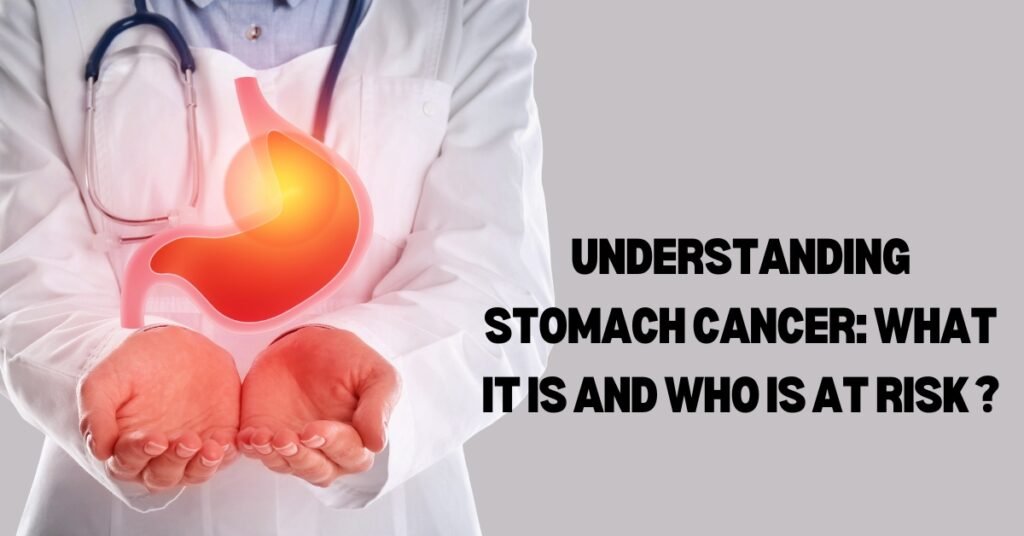
Stomach cancer, also known as gastric cancer, is a serious and often challenging diagnosis. As an oncologist, I frequently encounter patients and families seeking to understand this disease better, including its risk factors, symptoms, and prevention strategies. In this blog, I aim to provide a clear overview of stomach cancer, who is at risk, and what you can do to mitigate your risk. What Is Stomach Cancer? Stomach cancer occurs when abnormal cells in the stomach lining begin to grow uncontrollably, forming tumors. These tumors can invade and damage nearby tissues and organs. Stomach cancer is often classified into different types, with the most common being adenocarcinoma, which originates from the glandular cells of the stomach lining. The progression of stomach cancer can be divided into several stages, from early-stage cancer confined to the stomach lining to more advanced stages where the cancer has spread to nearby lymph nodes or distant organs. Early detection is crucial because stomach cancer is often asymptomatic in its initial stages, which makes it challenging to diagnose early. Symptoms of Stomach Cancer The symptoms of stomach cancer can be subtle and may resemble those of other, less serious conditions. Common symptoms include: If you experience any of these symptoms persistently, it is important to consult a healthcare professional for a thorough evaluation. Who Is at Risk for Stomach Cancer? Several factors can increase the risk of developing stomach cancer. While some of these factors are beyond our control, understanding them can help with early detection and prevention. Risk factors include: Preventive Measures and Early Detection While not all risk factors can be controlled, there are steps you can take to reduce your risk: Conclusion Stomach cancer is a serious condition with various risk factors and symptoms that can often be mistaken for other health issues. Understanding the risk factors and symptoms is crucial for early detection and prevention. If you have concerns about stomach cancer or are at higher risk, I encourage you to consult with a healthcare professional for personalized advice and appropriate screening options. Early diagnosis and treatment can make a significant difference in outcomes, so staying informed and proactive about your health is key. Together, we can work towards a future with better prevention, early detection, and treatment of stomach cancer.
Childhood Cancer Awareness Month: A Time to Reflect, Support, and Take Action
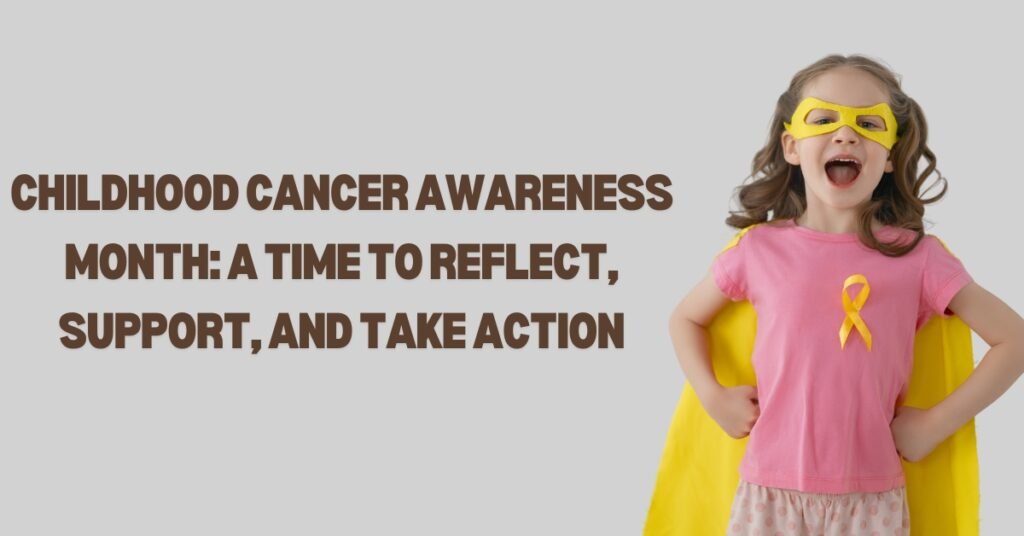
As September rolls around each year, it brings with it a time of reflection, hope, and action for those of us in the oncology community. This month is dedicated to Childhood Cancer Awareness—a cause that is both deeply personal and profoundly important to me as an oncologist. Childhood Cancer Awareness Month is not just a time to wear gold ribbons; it’s an opportunity to shine a spotlight on the unique challenges faced by young cancer patients and their families, to celebrate the victories we’ve achieved, and to acknowledge the work that still lies ahead. Understanding Childhood Cancer Childhood cancer is a broad term that encompasses a variety of cancers that occur in children under the age of 18. The most common types include leukemia, brain tumors, neuroblastoma, and lymphomas, among others. Unlike adult cancers, which are often linked to lifestyle or environmental factors, the causes of childhood cancers are largely unknown and can occur randomly without warning. Despite being relatively rare compared to adult cancers, childhood cancer remains the leading cause of death by disease for children in many parts of the world. Each year, thousands of children and their families face the unimaginable reality of a cancer diagnosis, embarking on a journey that is both physically and emotionally taxing. The Impact of a Childhood Cancer Diagnosis – Childhood Cancer Awareness Month The impact of a cancer diagnosis on a child is profound. It interrupts the most formative years of their life, affecting their education, social development, and overall well-being. The treatment process—often involving surgery, chemotherapy, radiation, and extended hospital stays—can be grueling. Children may miss out on the joys of childhood, and their families are thrust into a world of uncertainty, fear, and financial strain. However, it is not just the physical burden of the disease that we must address. The emotional and psychological toll on both the child and their family is significant. Parents often find themselves grappling with feelings of helplessness, while the child may struggle with the isolation and anxiety that can accompany long-term treatment. This is why comprehensive care, which includes psychological support, is crucial for these young patients. Advances in Treatment and Hope for the Future The good news is that we have made tremendous strides in the treatment of childhood cancers over the past few decades. Advances in research and treatment protocols have led to significant improvements in survival rates. For example, the survival rate for childhood leukemia has increased dramatically, with many children now living long, healthy lives post-treatment. But while these advances are encouraging, they are not the end of the story. The treatments that save lives can also have long-term side effects, impacting the child’s health well into adulthood. This is why ongoing research is essential—not just to find cures, but to develop treatments that are less toxic and more targeted, minimizing the long-term impact on survivors. How You Can Help Raising awareness during Childhood Cancer Awareness Month is about more than just recognizing the existence of this disease—it’s about taking action. Here are a few ways you can make a difference: 1. Support Research: Consider donating to organizations that fund childhood cancer research. These funds are critical for developing new treatments and ultimately finding a cure.2. Spread the Word: Use your voice to raise awareness. Whether through social media, community events, or personal conversations, spreading knowledge about childhood cancer helps bring attention to the cause.3. Support Families: If you know a family affected by childhood cancer, offer your support. This could be as simple as lending an ear, helping with day-to-day tasks, or connecting them with resources.4. Advocate for Change: Get involved in advocacy efforts that push for increased funding for childhood cancer research and better support for affected families. Your voice can help drive policy changes that make a difference. A Message of Hope As an oncologist, I have the privilege of witnessing the resilience and strength of young cancer patients and their families. While the journey is often long and difficult, the courage these children show is nothing short of inspiring. Childhood Cancer Awareness Month is a time to honor their bravery, remember those we have lost, and recommit ourselves to the fight against this devastating disease. Together, we can work towards a future where no child has to face cancer and where every child who does can look forward to a full, healthy life. Let’s make September a month of action, hope, and progress.
